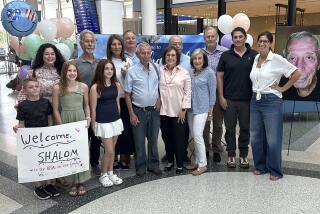Stalking a Killer
Doris Goldman is the quintessential professional. On a recent weekday, she is in her glass-walled office early, having made the short walk from a modern condominium complex across the street, home to hard-core Irvine business executives who can’t waste time on a long commute.
She has a lot on her mind today: the Chicago Tribune, Philadelphia Inquirer, 20-20. She has to get through to all of them. Twist their arms. Make them listen. The media can reach a lot of people fast.
Time is precious, so very precious. This is something Goldman knows painfully well.
She picks up a plastic photo cube on her desk showing pictures of her three children when each was a young adult. Nancy, her oldest daughter, lives in Encino. Sharon and Jack are dead.
Time ran out.
If Goldman has her way, no one will ever die again from long QT syndrome, the awkward name for the cardiac disorder that killed her two vibrant, athletic children without warning. She has made it her responsibility to warn others about the disease.
“Every place a story runs on this, we are bombarded with calls,” she says, shuffling a stack of newspaper clippings.
When Goldman picks up the phone to dial a reporter, she is polite but firm and to the point. Her voice does not waver.
“My son died at 20 . . . my daughter at age 29. . . . A dominant gene causes long QT. . . . Other families--no one knows just how many--carry the gene too. . . . Medication can control it. . . . Often the young person faints for no apparent reason. . . . But the first symptom is sometimes sudden death.”
Please write something, Goldman beseeches. Not enough people know about long QT.
And she is right.
In the last two years, researchers have begun to dramatically re-evaluate information on long QT syndrome, which is caused by a malfunction of the heart’s electrical system, leading it to beat wildly--and sometimes to stop.
The more doctors find out, they more they raise their estimates on the number of people who may carry the gene. Previously, the disorder was believed to affect about one person in 10,000, but that figure is now thought to be far too low.
“We just don’t know how common it is,” says Dr. G. Michael Vincent of the University of Utah, where pioneering work on long QT has been done. “We know it is more under-recognized than rare. But now a lot more families are being identified.”
The explosion of information on the disorder stems from two sources: One is the work of a handful of researchers, including the University of Utah group, which identified a genetic marker for the syndrome in 1991.
The other source is Goldman. Because of her efforts to alert unsuspecting families, dozens of families around the nation are being tested for the disorder.
“She’s fantastic,” says Vincent. “Her ability to tell her story has been extraordinarily important” in helping establish the Sudden Arrhythmia Death Syndromes (SADS) Foundation at LDS Hospital in Salt Lake City to identify long QT families and to support research.
“I can’t imagine the kind of strength Doris has,” says Toni DeBilzan, a Laguna Hills woman who lost her 19-year-old son, Josh Sergio, to long QT in 1991. “I can’t really put into words how I feel about Doris.” The DeBilzan family discovered they carry the gene after a story on Goldman appeared last year in the Orange County Register.
For her part, Goldman seems born to take charge. She has a resonant voice, which masks the perpetual lump in her throat. As she speaks, she crumples a tissue in one fist.
“I’m healthy because I’m throwing myself into this,” she says. “I’ve got to make a positive out of a negative.”
Besides, Goldman has other family members who carry the gene to think about. Sharon’s son, Jacob, who was 5 months old when his mother died in 1991, has been found to be a carrier.
“By the time Jacob ponders whether or not to have children, I hope we have some sort of genetic therapy for this,” Goldman says. “Or I hope we at least have enough awareness that the medical community will consider the possibility of long QT whenever a young person faints.”
Jack Toran, Goldman’s son, died in 1979 while on a camping trip in Grand Teton National Park. He had been working in construction in Wyoming before taking the short trek. Jack told his mother that he’d call her when he and his friends emerged from the park.
A few days after Jack’s trip began, Doris received a phone call about 11:30 one night. She recalls the conversation this way:
“Are you Jack Toran’s mother?”
“Is he OK?”
“Didn’t anyone call you? This is the coroner calling from Jackson Hole, Wyo.”
“Was he in an accident?”
“No. He died peacefully in his sleep.”
Apart from the shock of her son’s death, the words themselves made no sense to Goldman. Died peacefully in his sleep. How could that be? He was a young man, an athlete. He had never been seriously ill.
For almost two years, the family searched for a cause of death. The FBI investigated. Soil samples were taken in search of an unknown toxin.
Jack’s camping buddies had told Goldman that Jack had fainted at work a week before his death. Although the information meant little to Goldman at the time, it gave her chills two years later.
Sharon had just started college at the University of Tampa.
“Sharon called me in a panic and told me that she had fainted,” Goldman recalls. “That was the first inkling I had that something was happening to my children that might be hereditary.”
Sharon, a champion water-skier and runner, was examined thoroughly and found to have two possible heart problems: a slow, irregular heartbeat common among athletes and a mitral valve prolapse, a relatively common defect that is usually not serious. Neither was seen as a possible cause of sudden death.
But a year later, Sharon collapsed while walking across her dormitory room. Her heart stopped, and she was without oxygen for several minutes. When Goldman arrived in Tampa the next morning, Sharon was in a coma.
“A cardiologist sat me down and said there are three things that can cause cardiac arrest in a young person,” Goldman recalls. “One was long QT. I said, ‘Well, whatever it is, it has to be genetic.’ ”
Goldman was now certain that whatever killed Jack was trying to kill Sharon.
Sharon emerged from the coma in two weeks and then underwent six years of grueling rehabilitation because of brain damage caused by the loss of oxygen. She was put on beta blockers, a medication that controls the heart’s rhythms. Still, no one was certain what caused Jack’s and Sharon’s problems.
Sharon married John Turner in 1988 and moved to Encino, near Nancy. And Goldman, who had been living in Philadelphia, soon moved to Orange County to become area director of the Jewish American Committee.
Sharon gave birth to Jacob in February, 1991, and the happy new mother seemed to be thriving.
In May of that year, Goldman, an avid newspaper reader, saw an article on doctors finding a genetic marker for the long QT syndrome, “an inherited heart disorder that kills young and otherwise robust people without warning,” the article said.
That had to be it, Goldman told herself. She faxed the article to the family’s cardiologist, Dr. William J. Mandel in Beverly Hills. He urged Goldman to contact the Utah researchers.
Sharon’s records were sent to Utah. She was awaiting an appointment to be examined there when she died in her sleep.
Even though Sharon was taking beta blockers--which are now prescribed for people with long QT--doctors now believe the dose was too low.
And long QT was what Sharon and Jack had. It is what Jacob and Nancy and Doris and Doris’ sister, her sister’s two children and her first cousins have.
It took only a few weeks after Sharon’s death to find out, after Jacob and Nancy were evaluated in Utah.
It is not easy to identify long QT, which is named after an abnormally prolonged interval on an electrocardiogram. Researchers can do expensive DNA typing to explore a family’s genetic makeup to identify it. But in most cases, diagnosis must be made by looking at an electrocardiogram. And the diagnosis often is missed, Vincent says, because the characteristics do not always show up.
Usually, the disorder affects children and young adults. After age 40, people with long QT rarely die from it. Sudden death in young people can be precipitated by a stressful event, such as diving into a cold pool or being anxious.
“When a doctor sees a young person who is having episodes of loss of consciousness, and it’s not immediately apparent why that is, they should think of long QT syndrome,” Vincent says.
So, while doctors like Vincent and Mandel give seminars to their colleagues and publish papers, volunteers like Goldman ring up reporters, counsel frightened families--and save more lives.
The families that are identified with long QT agree that discovering you have the gene is unnerving, but it’s better than wondering why people in your family die without reason.
“When you have an answer, a part of you is relieved. You go, ‘OK, how do you deal with it?’ But there is still some fear,” DeBilzan says.
In part because of the recent awareness, the SADS Foundation has established a hot line, (800) STOP-SAD, to help families who think they may be affected by the disorder.
“A lot of times, with unexplained deaths, people will tune into an article like this and say, ‘Maybe that’s what happened,’ ” Mandel explains. “Many times, it’s not related. But if you can identify even one family, it’s worth it.”
And so, the calls come in. Goldman is ready.
She ticks off the cities where stories on her have appeared and where families have been identified. San Antonio. Las Vegas. New Orleans. St. Petersburg.
“The whole thing is gelling now,” she says, with some satisfaction. “The publicity is bringing all these people out who didn’t have a clue.”
More to Read
Sign up for Essential California
The most important California stories and recommendations in your inbox every morning.
You may occasionally receive promotional content from the Los Angeles Times.










